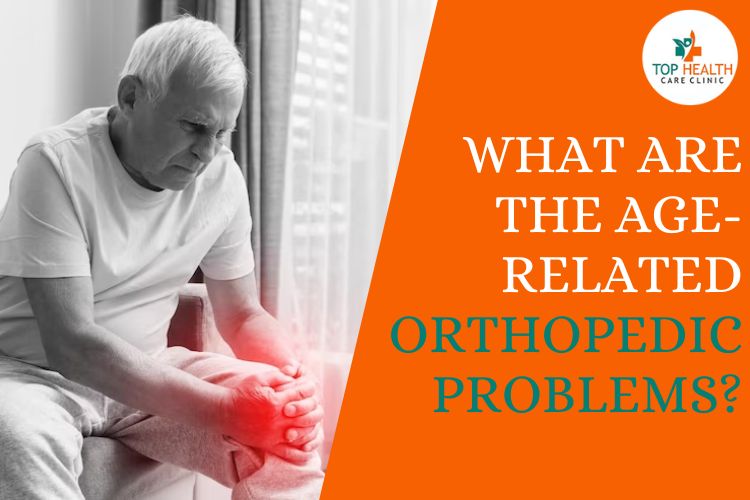What Are The Age-Related Orthopedic Problems?

As we grow older, our bodies undergo changes, including our musculoskeletal system. This system includes our bones, muscles, and joints. Over time, these body parts can become weaker, less flexible, and move slower. These changes can lead to an increased risk of falls and injuries. While aging is a natural part of life, there are ways to reduce the chances of specific health problems if we know how to take care of ourselves. In this article, we'll discuss common Orthopedic Problems that older adults may face and how to manage them.
1. Osteoarthritis
One common orthopedic issue that affects older people is osteoarthritis. This type of arthritis is often referred to as "wear and tear" arthritis because it happens as the cushioning cartilage at the ends of our bones wears down over time.
What Is Osteoarthritis?
Osteoarthritis can affect any joint in the body, but it's most common in the hip, knee, and spine. Here are some signs and symptoms of osteoarthritis:
1. Pain: Osteoarthritis often causes pain in the affected joint.
2. Grating Sensation: You might feel a grating or rubbing sensation in the joint when you move it.
3. Stiffness: The joint may become stiff, making it harder to move.
4. Loss of Flexibility: Your range of motion in the joint may decrease.
5. Bone Spurs: Extra bits of bone called bone spurs can develop around the affected joint.
6. Swelling and Tenderness: The joint may swell, and it can be tender to the touch.
2. Osteoporosis
Osteoporosis is another common condition that older adults may face. It occurs when the loss of bone mass happens faster than the creation of new bone. Our bodies typically create new bone at their peak around age 30, but as we age, this process slows down. However, in osteoporosis, bone loss accelerates, and new bone formation decreases more than usual. Several factors, including age, sex, race, genetics, and lifestyle, can increase the risk of osteoporosis.
Risk Factors For Osteoporosis:
1. Sex: Women are more susceptible to osteoporosis.
2. Race: White and Asian individuals are at higher risk.
3. Genetics: If someone in your family has had osteoporosis before, it can make you more likely to have it, too.
4. Body Frame: People with smaller body frames have less bone mass to rely on as they age.
5. Menopause: Hormonal changes in women during menopause can contribute to bone loss.
6. Thyroid Problems: An overactive thyroid can affect bone health.
3. Fractures
With age, muscles and bones weaken, making older adults more susceptible to falls and accidents. Conditions like osteoporosis further increase the risk of bone fractures. There are two types of fractures:
1. Closed Fracture: In this type, the broken bone doesn't break through the skin's surface.
2. Open Fracture: Here, the fractured bone is exposed or breaks through the skin.
Symptoms of a Fracture: If you or someone you know experiences a fracture, watch out for these signs:
1. Sudden Pain: A fracture typically causes sudden, sharp pain.
2. Swelling: The injured area may swell.
3. Deformity: The affected limb or bone may look deformed.
4. Bruising: Bruises may develop around the injured area.
It's crucial to seek immediate medical attention if someone, especially an older person, experiences a fall or injury that may have resulted in a fracture. Complications can arise, including infection if the skin is broken, excessive bleeding, and delayed healing.
4. Dislocations
A dislocation occurs when two bones connected by a joint move out of their normal position. This orthopedic issue commonly affects the shoulder, fingers, elbow, knee, and hip joints. Dislocations can be very painful and have symptoms such as:
1. Visible Deformation: The joint may look out of place.
2. Swelling and Discoloration: The affected area can swell and change colour.
3. Intense Pain: Dislocations are usually very painful.
4. Immobility: You may have trouble moving the affected joint.
Seek Medical Care for Dislocations: It can be challenging to tell a fracture from a dislocation because they have similar symptoms. That's why seeking immediate medical care for proper diagnosis and treatment is essential. Complications can occur if the dislocated joint isn't corrected promptly, including damage to blood vessels, a higher risk of further injuries, and tears in muscles or connective tissues.
Conclusion
Taking care of our musculoskeletal health as we age is essential to lead a happy and active life. Conditions like osteoarthritis, osteoporosis, fractures, and dislocations can affect us, but we can overcome these challenges with the proper guidance and care.
For the best orthopedic care in Faridabad, look no further than Top Healthcare Clinic. Dr. Tarun Kukreja is renowned as the best orthopedic doctor in Faridabad. His expertise in treating orthopedic conditions, including osteoporosis treatment in Faridabad, is exceptional.
Dr Tarun Kukreja and the team at Top Healthcare Clinic are dedicated to helping you maintain strong and healthy bones and joints. Whether you need preventive advice or treatment for an existing condition, they provide top-notch care that ensures you can enjoy an active lifestyle as you age.
Remember, your musculoskeletal health matters, and with the proper support, you can keep moving comfortably and confidently through the years. Trust Dr Tarun Kukreja and Top Healthcare Clinic to be your partners in musculoskeletal wellness.





